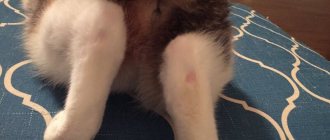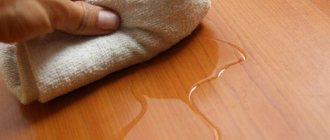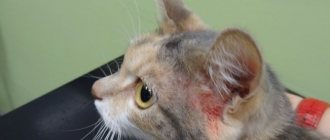12988Administration
4
It's a big decision to get a pet. Thus, we take responsibility for his well-being. But what if we encounter problems, for example, a cat’s fur is falling out in clumps, what should we do and how to help our pet?
What you are now faced with is not much like ordinary shedding, in which everything in the house is covered with an even layer of hair that has fallen from your cat. Now the wool is found in clumps. And you can often observe that this fur has come out along with part of the skin. Another unusual point is that the cat has bald patches here and there. And the skin turned red or scales or sores appeared on it.
© shutterstock
What are we dealing with? What kind of disease is this? Can we help our cat on our own? And should you seek help from a veterinarian?
Eosinophilic granuloma
Eosinophilic granuloma is an inflammatory disease of the oral mucosa and skin. As a rule, it occurs due to insect bites - fleas, mosquitoes or an allergic reaction to food components.
Symptoms:
- Single swollen areas in the oral cavity.
- Redness and swelling of the skin.
- Baldness at the site of redness.
- There is no pain or itching.
— Local lymph nodes swell.
- If lesions have developed in the mouth, the animal cannot eat and drink normally, and therefore signs of exhaustion and dehydration quickly increase.
Treatment:
Granuloma can only be cured with hormones, since there are no other means for this.
1. A course of antibiotic therapy.
2. Antihistamines, which can help in almost all cases, as they effectively relieve itching. This treatment is available at home, but you should still consult your veterinarian first.
3. Immunosuppressants such as cyclosporine or chlorambucil. They are useful if granuloma has developed against the background of autoimmune diseases.
4. Prescription of hydrocortisone. This drug also belongs to the hormonal category, but its use does not cause dangerous side effects.
============================================================================================================================================================================================
Your cat's fur is falling out: what to do?
First of all, it is necessary to analyze the situation, what lifestyle changes could provoke the situation: the food was changed, there was contact with other animals, potential carriers of infections, a child or another pet appeared in the house, which could cause stress, is it time for seasonal molting.
A growing kitten at 5-12 months actively changes its child's fur coat to an adult's one, this is normal. It is important to note the pet’s condition if it maintains its usual activity, is playful, eats well, its eyes and mucous membranes are healthy, clean, and there is no reason to worry.
If, along with the loss of fur, the cat experiences itching, scratches the skin until wounds, refuses to eat, the ears are red, the eyes turn sour, an urgent visit to the veterinary clinic is necessary.
Dermatomycoses
Dermatomycoses are infectious zooanthroponotic diseases with characteristic lesions of the skin and its derivatives, caused by pathogenic dermatophyte fungi.
Among animals, the most common are: trichophytosis, microsporia, scab.
Microsporia and trichophytosis are combined under one common name “ringworm”.
Symptoms:
- With microsporia - the appearance of limited spots of peeling and the formation of crusts on the skin of the paws, muzzle, and torso. The hair in the affected areas is sparse and breaks off easily. Lesions can be focal or disseminated.
- In cases of trichophytosis, sharply limited foci with broken hair and a flaky scaly surface or areas of inflamed skin and its follicles form on the skin in the area of the head, neck, torso, base of the tail and limbs.
Treatment:
1. When choosing medications, special increased skin sensitivity should be taken into account, and therefore it is necessary to give preference to products that have minimal irritating and cauterizing effects: Vaganova ointment (Lysol - 30.0; birch tar - 50.0; sulfur color and ASD, fraction 3—100.0 each; petroleum jelly—800.0), SK-9—chlorinated turpentine (200–500 ml per 10 liters of water), ROSC preparation, trichocetine (in the form of 2% liniment), phenothiazine (5% fish oil solution).
2. For disseminated lesions, the use of the antibiotic griseofulvin is indicated. It is prescribed orally at a dose of 2 mg per 1 kg of animal weight for 8-15 days.
============================================================================================================================================================================================
Flea dermatitis
Flea dermatitis is an inflammation of the skin caused by flea bites and an allergic reaction to their saliva. The severity of symptoms does not always depend on the number of parasites; sometimes one bite is enough for an intense pathological process.
Symptoms:
- Constant itching leading to scratching.
- Hair loss and the appearance of small nodules, most often on the back, lower back, sacrum, abdomen and thighs.
- Weeping areas in the natural folds of the skin (groin, armpits).
- Areas of redness with papules that subsequently crust over
- Hyperpigmentation.
- Often scratches become contaminated with pathological microflora, causing bacterial or fungal infections that aggravate the animal’s condition.
- The cat behaves restlessly, and in severe cases the appetite worsens.
Treatment:
1. Treat the animal with antiparasitic agents - drops, spray, shampoos. D
2. To kill fleas in the environment, insecticide solutions are used to wash bedding and rugs, wash floors, paying special attention to cracks and the space under baseboards.
3. To prevent scratching, put a protective collar on the cat and trim its claws. If the animal's itching was caused only by discomfort from flea bites and was not complicated by scratching or secondary infection, then no additional treatment is required.
In case of development of an allergic reaction and the presence of complications, the following drugs are additionally prescribed:
- Corticosteroid hormones are the main remedy for eliminating itching and inflammation in flea dermatitis. They are used both systemically and in the form of local forms (shampoos, ointments). In case of secondary infection, they are not used; in extreme cases, occasional use in small doses is allowed, mainly in the form of local forms.
- For severe itching and anxiety, sedatives are used.
- Drying agents - prescribed when there are wet areas of the skin.
- Antibacterial and antifungal agents - for minor scratching, they are used in the form of combined local preparations (for example, Sanoderm). When a secondary infection develops, systemic forms are prescribed.
- Multivitamin complexes with biotin and fatty acids accelerate the restoration of skin and coat.
If there is significant damage to the skin, it is advisable to trim the cat. This will make it easier to care for and heal scratches, and subsequently uniform and healthy hair will grow back.
============================================================================================================================================================================================
The cat is losing hair in clumps and has sores on the skin: causes and treatment
When a fungal infection occurs, the body becomes covered with small bald spots with round skin flakes. Ringworm is contagious to people; self-medication is strictly prohibited; laboratory tests will determine exactly what treatment will relieve the cat of the disease.
With seborrhea, the skin acquires an unpleasant odor, increased oiliness, and becomes inflamed. A scraping and blood test will help diagnose it. Erythema multiforme appears as a side pathology in oncology and other diseases. Ulcers, depression, watery blisters in the groin, armpits, profuse hair loss are its signs.
Solar dermatosis is more common in white-eared individuals; the skin turns red, peels, and later wounds appear.
Sores in a cat due to hair loss can occur when:
- alopecia areata;
- psychogenic, injection alopecia;
- folliculitis;
- sweat gland cysts.
It is not possible to diagnose the correct cause on your own; in any case, you need to consult a specialist, examine your skin and blood.
Scabies
The causative agents of scabies are microscopic mites that live on the surface of the skin and feed on blood and lymph.
Symptoms:
- Severe itching.
— Small papules can be found on the surface of the skin, most often localized near the ears, on the chest, abdomen, and joints.
— Focal hair loss, formation of ulcers. As a result of scratching, secondary bacterial infections occur.
Treatment:
1. Isolate the pet from household members.
2. Treat cat accessories.
3. Treat the affected areas with special ointments.
4. Give injections prescribed by your veterinarian.
5. Monitor the animal’s hygiene and do not take it out for walks until the end of treatment.
6. Provide your pet with a nutritious diet containing a sufficient amount of vitamins.
7. Carry out wet cleaning of the premises daily.
The therapy includes:
— Lime sulfur (LymDip) , a solution of which is applied once a week. A total of 6 procedures are performed. To improve contact of the medicine with the skin, the hair at the treatment site is cut. Before treating with sulfur, it is recommended to wash the cat with keratolytic shampoo.
— Ivermectin (Ivomec) is a drug that effectively relieves itching within the next 5 days after treatment. This unpleasant symptom disappears completely after a month.
— Amitraz (Mitaban) . Apply no more than 4 times every 2 weeks. Due to possible side effects, it is not recommended for use on dwarf cats, sick and elderly animals. — — Selamectin (REVOLUTION) is an avermectin drug that can be rapidly absorbed. It is completely safe, so it can be used to treat scabies in particularly sensitive animals. A single use is enough to destroy the infestation. Repeated treatment is carried out only in severe cases.
To treat mange, veterinarians often prescribe a drug called Stop Itch . It is available in the form of a suspension that has the ability to normalize the function of the skin without causing allergies. The drug is injected into the cat's mouth using a syringe without a needle.
============================================================================================================================================================================================
How to prevent hair loss in your hind legs
Not all causes of hair loss in cats can be prevented. However, you can take steps to keep your cat as healthy and happy as possible.
- Make sure your cat's personal stressors—whether environmental changes or another animal—are kept to a minimum so she doesn't resort to over-grooming out of frustration.
- Provide a nutritious diet, plenty of exercise, and regular veterinary checkups to avoid serious health problems.
- Give your cat an effective flea preventative monthly to prevent parasite infestations that can cause hair loss.
- Keeping your cat indoors will also reduce the likelihood of it becoming infected with many ticks.
Cats can lose hair on their back legs for a variety of reasons. The first step in treatment is to find out the underlying cause of hair loss on the hind legs. If you notice that your cat is losing hair, take her to the vet. The sooner the cause is diagnosed, the faster the cat will feel better and the fur will grow back.
Author of the article: Dr. Monica Tarantino . Small animal veterinarian in Charlotte, NC with five years of experience as a veterinarian. Dr. Tarantino often rescues pets in need and owns four dogs.
Demodicosis
Demodicosis is a skin disease in cats caused by the demodex mite.
Symptoms:
- Severe itching
- Focal hair loss with the formation of scales and crusts in areas of baldness. Demodicosis usually affects the head, ears and neck of cats.
- Generalized demodicosis can lead to widespread areas of hair thinning and baldness, and fluid-filled ulcers may form on the skin.
- Cats may begin to lick and groom their fur excessively, which leads to even more severe hair loss.
Treatment:
1. Bathing with anti-scabies shampoo. Bathing can be continued for 4 to 6 weeks to kill all mites as the shampoo does not affect their eggs. Treatment should continue until tests come back negative.
2. The drug amitraz can also be used, but it is toxic to cats and often leads to poisoning, so it must be used with extreme caution.
3. Take ivermectin daily or weekly for four weeks, however this is also not intended for cats and has a high risk of side effects.
============================================================================================================================================================================================
Why and when should you go to a veterinary clinic?
If a cat's hair is falling out profusely and in clumps, the first thing the owner should do is seek help from a veterinarian. Hair loss to bald spots can indicate a number of serious diseases.
Even an experienced owner will not always be able to independently determine that his pet is losing hair, because, for example, he has an endocrine disease. Only a veterinarian can do this after reviewing the cat’s hormone tests.
To establish a diagnosis, the cat needs to be examined by a doctor and undergo tests. From the place where the fur grows in clumps, they take a piece of skin for analysis and study the condition of the fur. These tests will show the overall picture of the disease and help develop treatment. Depending on the diagnosis, surgical or drug therapy is prescribed. The pet owner will only need to follow all the veterinarian's instructions.
Food allergies
Symptoms:
- Skin reaction. Itching manifests itself mainly on the face and head, ears, neck, paws and stomach.
- Hair loss. It occurs as a result of itching: the cat begins to itch, and this causes bald spots to appear on its fur - bare areas of skin.
- Wounds and ulcers. This is the next stage after the formation of bald spots, which occurs if the allergy is not treated: the animal will continue to itch. First, redness and irritation appear, in place of which painful wounds can form.
- Stomach upset. If the allergen is present for a long time in the cat’s diet, it begins to feel sick and loose stools appear.
- Edema. In the later stages of allergy development, the cat swells and has difficulty breathing.
Treatment:
1. Selection of hypoallergenic food.
2. To remove allergic reactions such as itching, drugs that have analgesic, antihistamine, decongestant and anti-inflammatory effects are used.
============================================================================================================================================================================================
Atopic dermatitis
One of the types of allergies that is caused by irritating external factors: pollen, dust, synthetic detergents.
Symptoms:
- Baldness.
-Pustules on the skin.
- Itching.
Treatment:
1. The doctor can prescribe broad-spectrum antimicrobial drugs in combination with antihistamines (Chlorpheniramine, Clemastil).
2. Non-steroidal anti-inflammatory drugs are prescribed.
3. If the animal’s condition is alarming, immunosuppressants are prescribed to suppress the “independent activity” of the immune system. Cyclosporine has proven itself well.
============================================================================================================================================================================================
Cheyletiosis
“Wandering dandruff” or cheyletiosis is caused by mites of the genus Cheyletiella. Animals develop dandruff along the spine line.
Symptoms:
- Severe itching.
- Minor hair loss, flakes, dandruff.
Treatment:
1. Injectable drugs: Pyrethrin, Fipronil.
2. Additionally, animal hair is treated with antiseborrheic shampoos. Long-haired cats need to have their fur trimmed first.
============================================================================================================================================================================================
Eczema
Eczema occurs in animals with sensitive skin. This disease is especially often diagnosed in “hairless” cats: sphinxes, elves, bambinos.
Symptoms:
- Itchy rashes, blisters, increased body temperature.
— Subsequently, the foci of infection on the skin dry out and peel off.
- In some cases, they degenerate into purulent wet wounds.
Treatment:
1. Soothing ointments and powders, as well as antibiotics and vitamins, are prescribed.
2. Dry eczema is treated with Vishnevsky ointment or naphthalan ointment.
3. Wet - zinc ointment, Lassar ointment. Before using ointments, damaged areas of the skin are treated with antiseptics: Chlorhexidine, Formalin, Miramistin.
============================================================================================================================================================================================
A cat's hair is falling out in clumps to the point of bald patches: what to do?
When shedding, the hair falls out evenly; if bald spots appear, this is an alarming signal, often accompanied by:
- runny nose;
- lacrimation;
- poor appetite;
- loss of body weight with a normal diet;
- peeling of bare skin;
- itching, anxiety, irritability;
- elevated temperature;
- bowel disorders.
In this case, it is necessary to exclude all possible causes of dermatitis: change the diet, choose a different type of tray filler, limit the use of household chemicals and be sure to show the animal to a doctor.
Acne
This bacterial infection affects the sebaceous glands. Acne in cats, just like in people, is a consequence of blockage and then inflammation of the sebaceous glands and hair follicles. The owner's attention is usually attracted to rashes located in the chin area and (less often) in the lower lip area.
Symptoms:
— Pustules all over the cat’s body.
- Black dots.
- Reddened skin bumps (papules).
Treatment:
The treatment is complex.
1. First, the animal is washed with tar soap or antiseborrheic shampoos.
2. Next, apply local antiseptics: “Chlorhexidine” or “Miramistin”.
3. In difficult cases, veterinarians prescribe local antibiotics: Mupirocin.
============================================================================================================================================================================================











